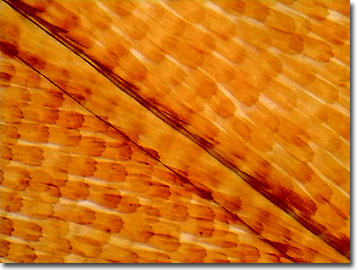Brightfield Digital Image Gallery
Butterfly Wing Scales
Butterflies and moths are unique insects partly because their entire bodies are covered by microscopic scales that aid in flight, waterproofing, and coloring. The digital image below, captured with the MIC-D microscope, is a relatively high magnification view of a butterfly wing revealing the intricate structure of the wing scale network.

Over 160,000 species of butterflies and moths together comprise a large order of insects named Lepidoptera, which is Greek for wing scale. There are a number of similarities and differences between butterflies and moths. Most butterflies are brightly colored and fly during the day while a majority of moths have a dull and drab appearance and usually fly by night. Butterflies tend to hold their wings upright over their backs when resting, but most moths spread their wings flat near the surface when not flying. These insects also differ in the construction of their antennae. Butterfly antennae are usually long and thin and knobbed at the tip, whereas moth antennae can be much more complex and often resemble feathers.
The first moths appeared about 150 million years ago, during the Cretaceous period when the Earth was largely inhabited by dinosaurs. Butterflies evolved much later, about 40 million years ago, and many of the species alive today have evolved during the last five million years.
Butterflies and moths have a complex life cycle that consists of four separate stages. The first stage is the egg, which is fertilized during a typical insect mating ritual. Male butterflies and female moths secrete airborne pheromones that act as sexual stimulants to members of the opposite sex. In many instances, courtship is highly complicated and involves the coloration of the partners, a prenuptial courtship flight, and specialized "dances" that lead to mating. The sex attractant pheromones are complex biochemicals that probably determine most aspects of this mating behavior.
Contributing Authors
Cynthia D. Kelly, Thomas J. Fellers and Michael W. Davidson - National High Magnetic Field Laboratory, 1800 East Paul Dirac Dr., The Florida State University, Tallahassee, Florida, 32310.
BACK TO THE BRIGHTFIELD IMAGE GALLERY
BACK TO THE DIGITAL IMAGE GALLERIES
Questions or comments? Send us an email.
© 1995-2025 by Michael W. Davidson and The Florida State University. All Rights Reserved. No images, graphics, software, scripts, or applets may be reproduced or used in any manner without permission from the copyright holders. Use of this website means you agree to all of the Legal Terms and Conditions set forth by the owners.
This website is maintained by our
Graphics & Web Programming Team
in collaboration with Optical Microscopy at the
National High Magnetic Field Laboratory.
Last Modification Friday, Nov 13, 2015 at 01:19 PM
Access Count Since September 17, 2002: 15732
Visit the website of our partner in introductory microscopy education:
|
|
